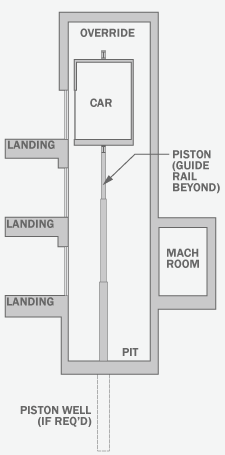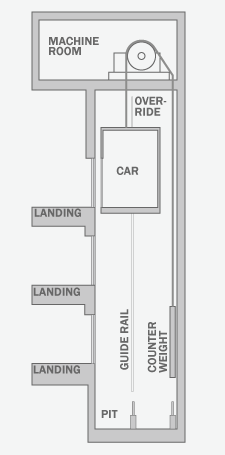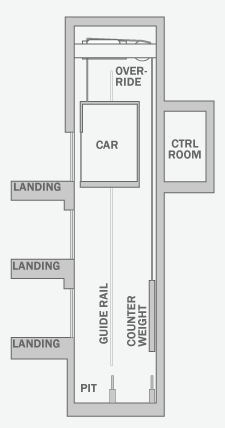Elevators are devices that move people and goods vertically within a dedicated shaft that connects the floors of a building. They became commonplace in the 1850s as steel and iron structural frames allowed taller construction; however it was Elisha Otis's safety mechanism that prevented the car from falling that made elevators popular. In almost all modern multi-floor buildings, elevators are required to provide universal access.
There are three main types of elevators commonly used: traction with a machine room, machine-room-less traction, and hydraulic; however, there are variations on each type.
Hydraulic Elevators

Hydraulic Elevator
Hydraulic elevators are supported by a piston at the bottom of the elevator that pushes the elevator up as an electric motor forces oil or another hydraulic fluid into the piston. The elevator descends as a valve releases the fluid from the piston. They are used for low-rise applications of 2-8 stories and travel at a maximum speed of 200 feet per minute. The machine room for hydraulic elevators is located at the lowest level adjacent to the elevator shaft.
Conventional Hydraulic Elevators have a sheave that extends below the floor of the elevator pit, which accepts the retracting piston as the elevator descends. Some configurations have a telescoping piston that collapses and requires a shallower hole below the pit. Max travel distance is approximately 60 feet.
Hole-less Hydraulic Elevators have a piston on either side of the cab. In this configuration, the telescoping pistons are fixed at the base of the pit and do not require a sheave or hole below the pit. Telescoping pistons allow up to 50 feet of travel distance. Non-telescoping pistons only allow about 20 feet of travel distance.
Roped Hydraulic Elevators use a combination of ropes and a piston to move the elevator. Maximum travel distance is about 60 feet.
Hydraulic elevators have a low initial cost and their ongoing maintenance costs are lower compared to the other elevator types. However, hydraulic elevators use more energy than other types of elevators because the electric motor works against gravity as it forces hydraulic fluid into the piston. A major drawback of hydraulic elevators is that the hydraulic fluid can sometimes leak, which can cause a serious environmental hazard. The environmental risk and high energy use are two main reasons that hydraulic elevators are not being installed as often as in the past.
Geared and Gearless Traction Elevators with Machine Room

Traction Elevator
Traction elevators are lifted by ropes, which pass over a wheel attached to an electric motor above the elevator shaft. They are used for mid and high-rise applications and have much higher travel speeds than hydraulic elevators. A counter weight makes the elevators more efficient by offsetting the weight of the car and occupants so that the motor doesn't have to move as much weight.
Geared Traction Elevators have a gearbox that is attached to the motor, which drives the wheel that moves the ropes. Geared traction elevators are capable of travel speeds up to 500 feet per minute. The maximum travel distance for a geared traction elevator is around 250 feet.
Gear-less Traction Elevators have the wheel attached directly to the motor. Gear-less traction elevators are capable of speeds up to 2,000 feet per minute and they have a maximum travel distance of around 2,000 feet so they are the only choice for high-rise applications.
Geared traction elevators are middle of the road in terms of initial cost, ongoing maintenance costs, and energy consumption. Gear-less traction elevators have a high initial cost, medium ongoing maintenance costs, and use energy a bit more efficiently than geared traction elevators.
It is important that traction elevator ropes and sheaves are checked for wear on a regular basis. As they wear, the traction between the sheave and the cables is reduced and slippage becomes more regular, which reduces the efficiency and can become dangerous if left unchecked.
Traction elevators have height restrictions that are governed by the length and weight of the cables or ropes. New materials that are stronger and lighter, such as carbon fiber, will allow traction elevators to achieve new heights.
Machine-Room-Less (MRL) Elevators

Machine-Room-Less Elevator
Machine-Room-Less Elevators are traction elevators that do not have a dedicated machine room above the elevator shaft. The machine sits in the override space and is accessed from the top of the elevator cab when maintenance or repairs are required. The control boxes are located in a control room that is adjacent to the elevator shaft on the highest landing and within around 150 feet of the machine.
Machine-room-less elevators have a maximum travel distance of up to 250 feet and can travel at speeds up to 500 feet-per-minute. MRL elevators are comparable to geared traction elevators in terms of initial and maintenance costs, but they have relatively low energy consumption compared to geared elevators.
Machine-room-less elevators are becoming the most popular choice for mid-rise buildings where the travel distance is up to 250 feet. They are energy efficient, require less space, and their operation and reliability are on par with gear-less traction elevators.
The main reason that MRL elevators have been adopted so slowly in the United States is because the building codes had provisions that didn't allow the motor to be within the hoistway. This is changing, but it is worth consulting with the local codes before specifying an MRL elevator.


